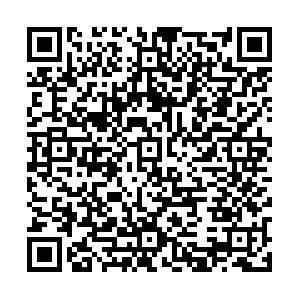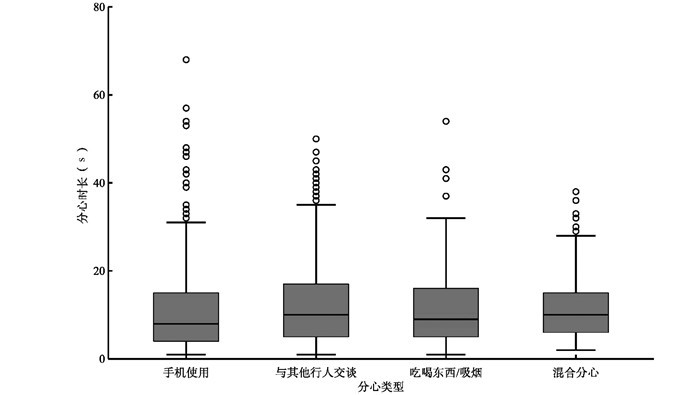Epidemiological characteristics of street-crossing distraction among pedestrians at road intersections in Changsha City based on video-taping
-
摘要:
目的 分析长沙市过街行人常见分心类型的流行特征。 方法 采用多阶段随机抽样获取研究对象,通过视频拍摄和人工转录获得长沙市20个十字交叉路口过街行人的常见分心发生率及其特征(包括:发生频次、分心时长)。采用χ2检验、Cochran-Armitage趋势检验、Kruskal-Wallis H检验进行统计分析。 结果 共观察到25 436名20岁及以上过街行人,分心发生率为34.32%(95% CI: 33.73%~34.90%),女性、20~<40岁、下午和周末出行行人的分心发生率分别高于男性、其他年龄组、上午和工作日出行者(均有P < 0.05)。手机使用、与其他行人交谈、吃喝东西/吸烟的发生率分别为11.06%、19.62%和2.13%。三类分心的发生频次均以1~2次为主,与其他行人交谈(10.0 s)的中位分心时长高于手机使用(9.0 s)和吃喝东西/吸烟(8.0 s)。 结论 长沙市十字交叉路口过街行人分心发生率高,与其他行人交谈和手机使用是最常见的分心类型。不同分心类型的发生频次和分心时长存在差异。 Abstract:Objective To analyze the incidences and epidemiological characteristics of common types of street-crossing distraction among pedestrians in Changsha City. Methods Multi-stage random sampling was used to obtain study objects. Video-taping and artificial transcription were used to obtain the data of common types of distraction and their characteristics (including frequency and duration of distraction) among street-crossing pedestrians at 20 road intersections in Changsha. Chi-square test, Cochran-Armitage trend test, and Kruskal-Wallis H test were used for statistical analysis. Results A total of 25 436 pedestrians aged 20 years and older were observed, with distraction incidence of 34.32%. Females, pedestrians aged 20- < 40 years and appeared in the afternoon and weekend had higher incidences of distraction than males, other age groups, and appeared in the morning and weekday (all P < 0.05). Mobile phone use, the incidences of talking with other pedestrians, and eating/drinking/smoking were 11.06%, 19.62%, and 2.13%, respectively. One to two times was the most common frequency among three types of distraction. The median of total duration of distraction for talking with other pedestrians (10.0 s) was higher than mobile phone use (9.0 s) and eating/drinking/smoking (8.0 s). Conclusions Street-crossing distraction was prevalent among pedestrians at road intersections in Changsha City. Talking with other pedestrians and mobile phone use were the most prevalent type of distraction. The frequency and duration of distraction differed significantly among different types of distraction. -
Key words:
- Pedestrian /
- Street-crossing distraction /
- Incidence /
- Epidemiological characteristics
-
表 1 长沙市十字交叉路口过街行人的一般特征
Table 1. Basic characteristics of street-crossing pedestrians at road intersections in Changsha
变量 人数[n(%)] 性别 男性 10 886(42.80) 女性 14 550(57.20) 年龄组(岁) 20~<40 15 111(59.41) 40~<60 7 741(30.43) ≥60 2 584(10.16) 出行时段 上午 13 672(53.75) 下午 11 764(46.25) 工作日/周末 工作日 14 217(55.89) 周末 11 219(44.11) 合计 25 436(100.00) 表 2 长沙市十字交叉路口不同特征过街行人的分心发生率比较
Table 2. Comparison of distraction incidences of pedestrians with different characteristics at road intersections in Changsha
特征 分心人数 发生率(95% CI)值 χ2值 P值 性别 8.91 0.003 男性 3 624 33.29 (32.41~34.18) 女性 5 105 35.09 (34.31~35.86) 年龄组(岁) 1 074.00 < 0.001 20~<40 6 367 42.13 (41.35~42.92) 40~<60 1 939 25.05 (24.08~26.01) ≥60 423 16.37 (14.94~17.80) 出行时段 540.72 < 0.001 上午 3 814 27.90 (27.14~28.65) 下午 4 915 41.78 (40.89~42.67) 工作日/周末 9.67 0.002 工作日 4 762 33.50 (32.72~34.27) 周末 3 967 35.36 (34.47~36.24) 合计 8 729 34.32 (33.73~34.90) 表 3 长沙市十字交叉路口过街行人的不同分心类型发生率
Table 3. Incidence of different types of distraction among street-crossing pedestrians at road intersections in Changsha
分心类型 分心人数 发生率(95% CI) χ2值 P值 手机使用 2 814 11.06 (10.68~11.45) 127.48 < 0.001 与其他行人交谈 4 991 19.62 (19.13~ 20.11) 吃喝东西/吸烟 542 2.13 (1.95~ 2.31) 混合分心 382 1.50 (1.35~1.65) 表 4 长沙市十字交叉路口过街行人的分心发生频次[n(%)]
Table 4. Frequency of distraction among street-crossing pedestrians at road intersections in Changsha [n(%)]
分心类型 发生频次 χ2值 P值 1次 2次 ≥3次 手机使用 2 237(79.50) 419(14.89) 158(5.61) 1 055.437 < 0.001 与其他行人交谈 3 363(67.38) 1 269(25.43) 359(7.19) 吃喝东西/吸烟 281(51.85) 181(33.39) 80(14.76) 混合分心 0(0.00) 256(67.02) 126(32.98) 合计 5 881(67.37) 2 125(24.34) 723(8.28) -
[1] The Free Dictionary. Distraction[EB/OL]. [2022-02-14]. https://encyclopedia.thefreedictionary.com/Distractions. [2] 宁佩珊, 胡国清. 行人分心流行特征与干预研究进展[J]. 中华流行病学杂志, 2022, 43(2): 277-281. DOI: 10.3760/cma.j.cn112338-20210629-00503.Ning PS, Hu GQ. Progress on epidemiological characteristics and interventions of pedestrian distraction[J]. Chin J Epidemiol, 2022, 43(2): 277-281. DOI: 10.3760/cma.j.cn112338-20210629-00503. [3] Schwebel DC, Stavrinos D, Byington KW, et al. Distraction and pedestrian safety: how talking on the phone, texting, and listening to music impact crossing the street[J]. Accid Anal Prev, 2012, 45(2): 266-271. DOI: 10.1016/j.aap.2011.07.011. [4] 赵艳, 刘东, 王竞雄. 北京市行人过街使用手机对交通安全影响研究[J]. 中国人民公安大学学报(自然科学版), 2015, 21(2): 58-62.Zhao Y, Liu D, Wang JX. Study on the impact of pedestrian mobile phones use on traffic safety in Beijing[J]. Journal of People's Public Security University of China (Science and Technology), 2015, 21(2): 58-62. [5] 张存保, 陈峰, 韦媛媛, 等. 无信号控制路段手机对行人过街行为和安全的影响[J]. 交通运输系统工程与信息, 2018, 18(2): 136-141. DOI: 10.16097/j.cnki.1009-6744.2018.02.021.Zhang CB, Chen F, Wei YY, et al. The effects of mobile phone on pedestrian crossing behavior and safety at uncontrolled mid-block crosswalks[J]. Journal of Transportation Systems Engineering and Information Technology, 2018, 18(2): 136-141. DOI: 10.16097/j.cnki.1009-6744.2018.02.021. [6] Zhang WH, Wang K, Wang L, et al. Exploring factors affecting pedestrians' red-light running behaviors at intersections in China[J]. Accid Anal Prev, 2016, 96: 71-78. DOI: 10.1016/j.aap.2016.07.038. [7] Hamann C, Dulf D, Baragan-Andrada E, et al. Contributors to pedestrian distraction and risky behaviours during road crossings in Romania[J]. Inj Prev, 2017, 23(6): 370-376. DOI: 10.1136/injuryprev-2016-042219. [8] Le B, Figueroa C, Anderson C, et al. Determining the incidence of distraction among trauma patients in all modes of transportation[J]. J Trauma Acute Care Surg, 2019, 87(1): 87-91. DOI: 10.1097/TA.0000000000002293. [9] Wells HL, McClure LA, Porter BE, et al. Distracted pedestrian behavior on two urban college campuses[J]. J Community Health, 2018, 43(1): 96-102. DOI: 10.1007/s10900-017-0392-x. [10] Bungum TJ, Day C, Henry LJ. The association of distraction and caution displayed by pedestrians at a lighted crosswalk[J]. J Community Health, 2005, 30(4): 269-279. DOI: 10.1007/s10900-005-3705-4. [11] Violano P, Roney L, Bechtel K. The incidence of pedestrian distraction at urban intersections after implementation of a Streets Smarts campaign[J]. Inj Epidemiol, 2015, 2(1): 18. DOI: 10.1186/s40621-015-0050-7. [12] Poó FM, Ledesma RD, Trujillo R. Pedestrian crossing behavior, an observational study in the city of Ushuaia, Argentina[J]. Traffic Inj Prev, 2018, 19(3): 305-310. DOI: 10.1080/15389588.2017.1391380. -





 下载:
下载:

